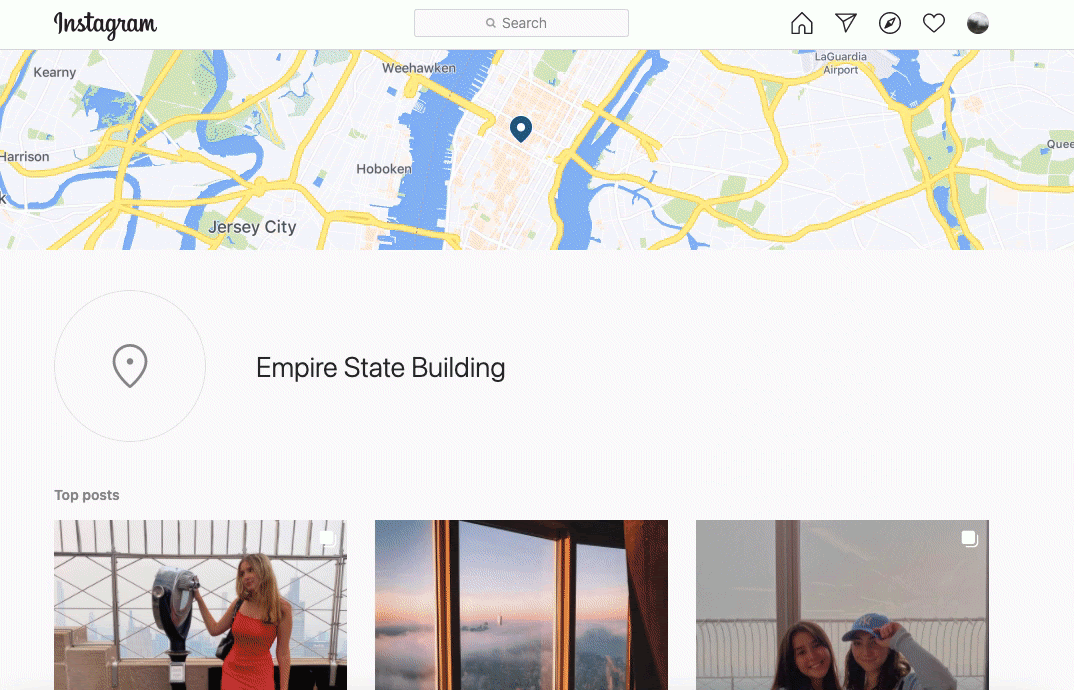Using a photo that isn’t your own can be a scary thing if you’re a destination marketer. When it comes to user-generated content (UGC) for destinations, the rules regarding usage rights are murky at best. They often lead to confusion on if and where you can re-share a visitor’s photo. In this article, we provide six of the most common questions we get about UGC and provide some best practices, too.
Your Top Questions, Answered
1.) Can we embed photos on our website from Instagram?
This is by far the most frequent question we get at Simpleview regarding UGC images. As of now, the answer is yes. If an Instagram user on a public account shares a photo, that photo is eligible to be embedded on your website. How do we know? Because Instagram provides the embed link. To see for yourself, select any public photo on Instagram.com and click the “…” button on the upper right corner of it. You’ll see that Instagram provides an embed code.

You could place that embed code on your website right now. The embed code, which you cannot alter, will have three critical components wherever you place it:
- The person’s username on display (crediting the photographer)
- A link to the original post on Instagram
- The option for the person to remove your ability to display their photo (accomplished by deleting the photo or making their account private)
Now, just because you can embed photos from Instagram on your website now, doesn’t mean you’ll be able to in the future. Instagram could pull the plug and disable public embeds, although there are no indications of this happening anytime soon.
2.) Isn’t embedding a photo for use on my website “stealing” it?
The best way to answer this question is with an analogy: let’s say you’re running the marketing for a stadium and your next concert is Taylor Swift. You want to promote the concert on your website, but you obviously don’t have the distribution rights to any Taylor Swift songs. You can’t download them and then reupload them to your website. What do you do? You embed a Spotify playlist or an official video from Taylor’s official YouTube account.
Embedding an Instagram photo is no different. You’re not taking a file and putting it on your website. You’re instead cutting out a window on your website and having it look directly to another website.
The ability to embed without needing permission goes back to a court ruling in 2007. Back then, the U.S. Court of Appeals for the Ninth Circuit ruled on a lawsuit involving Google’s use of image thumbnails. The ruling established something called “the server test,” which essentially says copyright infringement only exists if you’re hosting the image on your own servers. If you’re embedding an image, you’re not hosting the image on your own servers — you’re sharing the image that’s hosted on Instagram.
Clear as mud? It’s less complicated than it sounds. Just remember that embedding refers to including images, GIFs, videos and links in your content, not moving it onto your server.
3. When do I need to request rights to use a photo?
You need to get the rights from the photographer when you take a photo off Instagram.com and download the actual JPG of that file, including screenshotting it and downloading the screen shot. Essentially, if you’re not embedding the photo, you need to get rights for using it. If you do successfully get the rights, it’s always best practice to credit the photographer.
4. What are the drawbacks of embedding?
With embedding, you get what you pay for — and you don’t pay anything. Your ability to embed anyone’s public photo without notice is countered by their ability to remove their photo without notice. If you embed a photo on your website, there’s a good chance that one day it will be gone. A photographer may make their account private, or just simply delete the photo. If they do either, the embed link will no longer work.
5. What do you recommend for embedding?
We recommend using a Crowdriff gallery, which is a collection of embedded images. Instagram lets you embed only one photo at a time, while using a preferred partner tool like Crowdriff enables you to embed hundreds of photos into a single gallery and customize how they’re displayed. Another benefit is that if one photo in your Crowdriff gallery gets deleted by an Instagram user, another takes its place automatically. The best way to put embedded images on your website and have a consistent, attractive collection of images on display is through a tool, preferably Crowdriff.
6. Will embedding always be available?
Nothing on the internet is permanent these days. For over 14 years, platforms that allow embedding have been under legal scrutiny. Even right now, there’s a lawsuit in California involving Instagram and photographers.
For nearly a decade and a half, embedding has held up legally in court. That gives us confidence that embedding isn’t going away anytime soon. However, times change and nothing is guaranteed.
Best practices
With your top questions answered, let’s turn to some best practices that we recommend:
- Avoid close-ups of people’s faces. Even if an Instagram photo is public and eligible to be embedded, you should practice common courtesy. If someone has shared a shot of their face up close or of themselves in a swimsuit, you want to avoid it. Not because it’s illegal to re-share it, but because it's just not the courteous thing to do.
- If someone tagged you or hashtagged you, let them know their photo is being used. An embedded photo already gives credit to the photographer, but it doesn’t give them a notification, so let the photographer know. In all likelihood, if they tagged or hashtagged you, they’ll be thrilled that you’ve embedded their photo.
- Use a tool that allows you to make social media galleries and not just single image embeds. Instagram users delete their accounts and photos all the time. Don’t end up with a blank space on your website where you used to have a single embedded photo. Tools like Crowdriff allow you to create galleries of multiple photos that mean you’ll never end up with blank spaces on your website.
[Disclaimer:] The embedding feature on Instagram is controlled by Instagram and can be turned off at any moment. While this is highly unlikely to happen without advance notice, it is a possibility. Instagram has removed public features before and could do so again. We do not expect this to happen in the near future, but it will always be a possibility.

